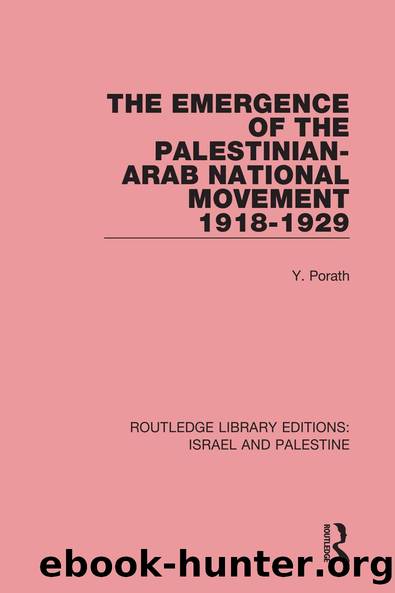The Emergence of the Palestinian-Arab National Movement, 1918-1929 (RLE Israel and Palestine) by Yehoshua Porath

Author:Yehoshua Porath [Porath, Yehoshua]
Language: eng
Format: epub
Tags: Foreign Language Study, Arabic, French, Political Science, Political Ideologies, Nationalism & Patriotism, Social Science, Regional Studies
ISBN: 9781000156089
Google: fHP2DwAAQBAJ
Publisher: Routledge
Published: 2020-08-18T03:51:38+00:00
* This chapter is based on my article âAl-ḤÄjj AmÄ«n al-Ḥusayni, Mufti of JerusalemâHis Rise to Power and the Consolidation of His Positionâ, Asian and African Studies, Vol. 7 (1971), pp. 121â56.
Chapter Five
THE ORIGIN OF THE OPPOSITION AND ITS DEVELOPMENT
The internal political division which marked the Palestinian national movement from the start was above all a product of the structure of Palestinian society. The growth of the power of the urban élite in the course of the nineteenth century stimulated internal competition among the families for positions of influence in the political and social centres of power: municipalities, provincial councils, the administrative and legal apparatus etc. The rise of this élite occurred, as we have seen, at the expense of the rural élite, which was extremely bitter over its loss of power and influence.
The joining of the districts of Jerusalem, NÄblus and Acre into one political unit led to the extension of the hegemony of the Jerusalem élite beyond the limits of its own district until it included all of Palestineâmuch to the frequent bitterness of the other urban élites. The internal political division in the Palestinian camp was a political expression of this social division.
The varied sources of this splitâcompetition among families, the rivalries existing between city and village, and the various districtsâled to a complexity which made the division hard to define. The camp supporting the AE and the SMC (the Ḥusayni group) was, it is true, more or less united in loyalty to the accepted leadership and to a certain political structure. But the opposing camp (the NashÄshÄ«bi factionââthe Oppositionâ) was far more variegated; its leadership was largely local, and the political conceptions current within it were far from being homogeneous. What nevertheless characterizes this camp and allows it to be seen as a phenomenon having more shared elements than differentiating ones, is its opposition to the leadership of the al-Ḥusayni family and to the policy of non-cooperation in self-governing institutions (the legislative council and similar bodies).
Download
This site does not store any files on its server. We only index and link to content provided by other sites. Please contact the content providers to delete copyright contents if any and email us, we'll remove relevant links or contents immediately.
Housekeeping by Marilynne Robinson(4347)
Papillon (English) by Henri Charrière(4195)
The Poetry of Pablo Neruda by Pablo Neruda(4039)
World without end by Ken Follett(3428)
TCP IP by Todd Lammle(3134)
Fluent Forever: How to Learn Any Language Fast and Never Forget It by Gabriel Wyner(3028)
The Rape Of Nanking by Iris Chang(2774)
How Proust Can Change Your Life by Alain De Botton(2742)
The Alchemist by Paulo Coelho(2644)
The Partner by John Grisham(2346)
Two lives by Helen Naylor(2270)
Hitler by Ian Kershaw(2152)
Yerma by Federico García Lorca(2016)
Sophie's World by Jostein Gaarder(1968)
Smilla's Sense of Snow by Peter Hoeg(1905)
Merriam-Webster's Pocket Dictionary by Merriam-Webster(1882)
Twilight of Idols and Anti-Christ by Friedrich Nietzsche(1850)
Il cavaliere inesistente by Italo Calvino(1825)
Deep Writing by Eric Maisel(1784)
